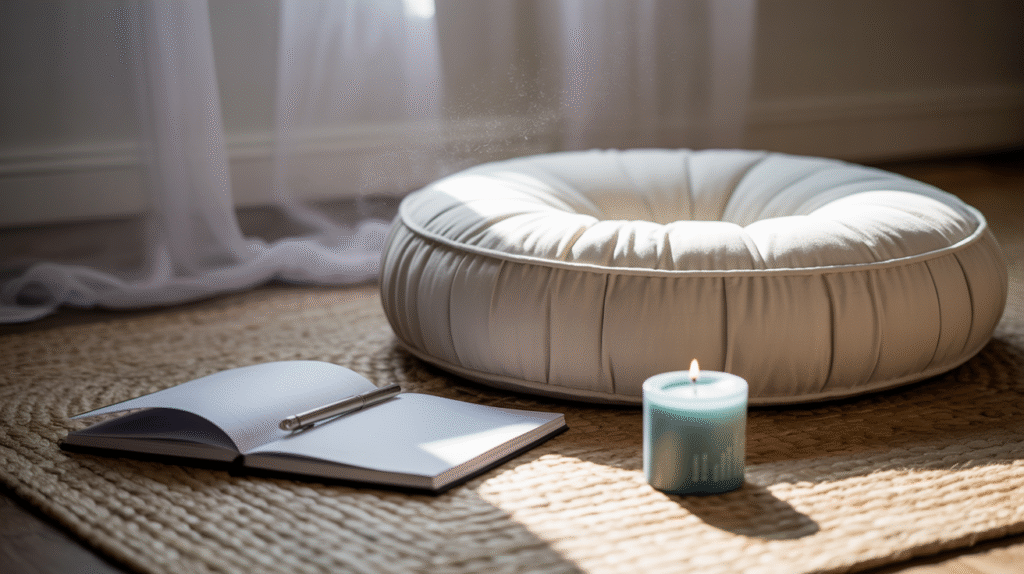
You sit down, close your eyes, and try to breathe… but within seconds, your mind is racing. Thoughts pile in like traffic during rush hour—groceries, deadlines, past conversations, random worries. You open your eyes and think, “I’m just not built for meditation.”
If that sounds familiar, you’re not alone. Many people believe that meditation requires a perfectly calm, empty mind—and that if they can’t achieve that, they’re failing. But the truth is, a busy mind doesn’t disqualify you from meditation—it’s actually the reason to do it.
Meditation isn’t about stopping thoughts. It’s about learning to relate to them differently, with less judgment and more curiosity. And yes, you can build a powerful meditation habit even if your mind never seems to slow down.
In this article, you’ll learn practical, forgiving strategies to create a meditation habit that sticks—no inner peace required (yet).
One of the biggest reasons people give up on meditation is because they misunderstand what it’s supposed to feel like. There’s a myth that meditation means sitting in stillness with a perfectly clear mind—no thoughts, no distractions, just pure peace.
But here’s the truth: your mind isn’t supposed to be silent. Meditation isn’t about suppressing your thoughts—it’s about observing them without getting caught up in them.
Think of it like this: if your mind is a river, meditation helps you sit on the bank and watch the thoughts flow by, instead of diving in and getting swept away. The goal isn’t to stop the current—it’s to learn not to fight it.
There are many valid forms of meditation that don’t require emptiness:
If your mind wanders during meditation, congratulations—you’re human. The act of noticing that drift and returning to your point of focus is the real exercise. That’s the mental rep that builds awareness over time.

When you’re trying to build a habit—especially one that feels mentally challenging—starting small is everything. One of the biggest mistakes people make with meditation is thinking they need to commit to 20 minutes a day right away. That’s a fast track to frustration and inconsistency.
Instead, start with just 2 minutes.
Two minutes might not seem like much, but it lowers the resistance dramatically. It’s short enough that your brain won’t put up a fight. And most importantly—it gets you started. Once you sit down and begin, you’ve already won.
Here’s a beginner-friendly progression to try:
Keep your focus simple. Just sit comfortably, close your eyes, and bring your attention to your breath. When your mind wanders (and it will), gently come back to the inhale and exhale.
Small doesn’t mean weak. In fact, it’s the most sustainable way to build strength—in your body and in your mind.
One of the most underrated secrets to building a meditation habit is removing friction. The easier it is to begin, the more likely you are to follow through—especially on busy or stressful days.
To make meditation automatic, you need three things:
Choose a time that naturally fits into your day. Right after waking up? After lunch? Just before bed? The more predictable, the better. Pair it with an existing habit, like brushing your teeth or making coffee.
You don’t need a Zen temple—just a spot where your brain learns “this is where I meditate.” It could be a chair, a corner of your room, even a spot on the floor with a cushion. Keep it tidy and inviting.
Cues trigger habits. Use visual or sensory reminders like:
The goal is to eliminate decision fatigue. When you know where, when, and how to start, you remove the mental barrier that often derails even your best intentions.
Design your habit to feel natural, not forced—and it will grow with less resistance.

Let’s be honest: distraction isn’t the exception in meditation—it’s the rule. Your mind will wander. You’ll remember emails, replay conversations, think about dinner, or suddenly itch your nose. It’s not a sign that you’re failing—it’s the exact moment the real practice begins.
Distraction is part of the process, and learning how to respond to it is where meditation becomes powerful. Here’s a simple 3-step way to handle it:
Each time you do this, you’re training your brain to come back to the present—just like a mental push-up. That’s how focus strengthens over time.
It’s important not to judge yourself when this happens. Don’t label a session as “bad” just because you were distracted. If you showed up and practiced returning, you succeeded.
You’re not trying to control your thoughts—you’re learning not to be controlled by them.
You don’t need a quiet mind to meditate. You need a willing mind—a mind that’s open to showing up, even when it feels messy or restless. In fact, the busier your thoughts, the more you stand to gain from practicing stillness.
Building a meditation habit when your mind never slows down isn’t about perfection—it’s about repetition. It’s about showing up for two minutes a day, learning to breathe through distraction, and creating a gentle space for awareness to grow.
Over time, those scattered thoughts won’t disappear—but your relationship to them will change. You’ll become more grounded, more present, and more able to pause before reacting. That’s the real gift of meditation.
Give yourself permission to start small, be imperfect, and trust the process. Your mind doesn’t have to be quiet to find peace—it just has to be willing.